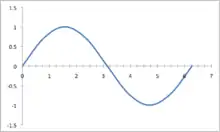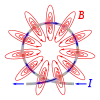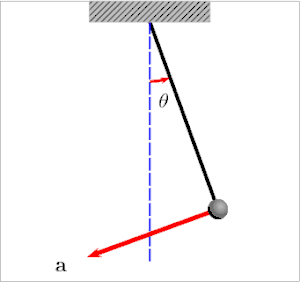Force
Force is a physical quantity that interacts with matter to perform a task
Force Definition Notation Formula Motion Force Force that sets matter in motion Impulse Force that sets a mass in motion Opposition force Force that opposes the interacting force with matter Pressure force Force that acts on surface's area Friction Force Force opposes matter movement on a surface Elastic Force Force that restores matter equilibrium Circulation Force Force sets matter in circular motion Centripetal Force Force that sets matter moves out of circulation motion Centripugal Force Force that sets matter moves in of circulation motion Electrostatic Force Attraction force of 2 different polaity charges Electromotive Force Force sets electric charge in motion Electromagnetomotive Force Force that sets moving electric charge to move perpendicular to the intial travel direction Electromagnetic Force Summation of 2 force Electromotive force and Electromagnetomotive force
Motion
Movement of matter from one place to another place caused by a force
Uniform linear motion
Motion that follows straight path of constant speed for example horizontal uniform linear motion, vertical uniform linear motion,
Notation Horizontal uniform linear motion Vertical uniform linear motion Inclined uniform linear motion Distance s Time t Speed v Acceleration a Force F Work W power E
Non uniform curve motion
Motion that does not follow a straight path
Notation Formulas Distance s(t) Time t Speed v(t) Acceleration a(t) Force F(t) Work W(t) Energy E(t)
Periodic motion
Motion that keeps repeat itself over a period of time
Circular motion
Motion that follows a circular path
Full circle motion
Motion that completes a circle
Notation Formulas Distance s Time t Speed v Angular speed ω Acceleration a Force F Work W Energy E
Circle's arc motion
Motion that follows an arc of a circle
Notation Formulas Distance s Time t Speed v Angular speed ω Acceleration a Force F Work W Energy E
Wave
Mathematical formula
A period motion of a sinusoidal motion
Notation Formulas Distance s Time t Speed v Angular Speed ω Frequency f Wave equation f"(t) Wave function f(t)
Sinusoidal wave
Mathematiccaly sinusoidal can be represent by a wave equation and a wave function
Wave equation
Wave function
Oscillation
Spring's Oscillation
Spring's Oscillation Symbol Horizontal Vertical Spring's Oscillation equation Spring's wave function Angular speed ω
Pendulum Oscillation
The differential equation which represents the motion of a simple pendulum is
where g is acceleration due to gravity, l is the length of the pendulum, and θ is the angular displacement.
Electric Oscillation
Electric's Oscillation RLC series at equilibrium RLC series at resonance LC series at equilibrium LC series at resonance 



Wave equation Wave function 
Electromagnetic Oscillation
Electromagnetic's Oscillation Formula Wave equation
Wave function Angular speed Time constant Wave hape 
Momentum
Momentum is defined as motion of a mass at a speed caused by a force
Moment
Momentum of a mass in motion
Notation Formulas Mass m Speed v Moment p Impulse(Force) F Work W Energy E
Momentum of a relativistic mass in motion
Momentum refers to movement of a mass at a speed relative to the speed of light
Notation Formulas Mass m Speed v Momentum p Force F Work W Energy E
Momentum of a massless quanta in motion
Momentum refers to movement of a mass at a speed equals to the speed of light
Notation Formulas Speed v Work W Quanta h Momentum p Wavelength
Momentum of electric charge
Momentum of free electron
Absorbing photon, electron becomes free electron travels outward off the atom's circular orbit
Momentum of a bind electron
Releasing photon, electron becomes free electron travels inward off the circle orbit
Heat
Temperature
Temperature is the measurement of heat's intensity . Temperature is denoted as T measured in degree o
Temperature measurements
There are 3 temperature measuring system
- Degree Celcius,
- Degree Kevin ,
- Degree Fahrenheit ,
Conversion between systems of temperature can be done as shown below
Convert from to ' Formulas Degree Fahrenheit Celsius °C = (°F – 32) / 1.8 Degree Celsius Fahrenheit °F = °C × 1.8 + 32 Degree Fahrenheit Kelvin K = (°F – 32) / 1.8 + 273.15
Standard temperatures
Standard temperature Value Room temperature Boiling temperature Frozen temperature
Heat and matter
Heat and matter interact to create Heat transfer of three phases Heat conduction, Heat convection and Heat radiation
Heat absortion of matter
- Matter of dark color absorbs more heat energy than matter of bright color
- Matter of thin dimension absorbs more heat energy than matter of thich dimension
For example
- Dark and thin clothes dry faster than bright and thick clothes
Heat Transfer
A process of heat interaction with matter through 3 phases of
Heat conduction
Matter change its temperature when it in contact with heat energy
Heat convection
Matter absorbs heat energy to its maximum level and gives off visible light
Heat radiation
Matter is at its saturation . Matter is no longer absorbs heat energy and use the excess energy to release electron of its atom
Heat flow
Heat flows between 2 objects of different mass follows heat flow rule that heat flows from high temperature to low temperature
Heat energy absorb by mass 1
Heat energy absorb by mass 2
Direction of heat flow
Light
Speed of visible light
Speed of light is denoted as C which has a value
- m/s
Measurement speed of visible light
In vacuum By Michael Morrison In air, as electromagnetic radiation By James Clerk Maxwell In liquid By Lorentz
Visible light
Characteristics
Visible light travels at a constant speed in vacuum and in air which has a value
- m/s
Travels as Electromagnetic wave of wavelength
- m
Of Threshold frequency
- Hz
Composite colors
Visible light passes through prism decomposes itself into its composites color light of 6 colors
Colors Wavelength Angle of refraction Red Orange Yellow Green Blue Violet
Light and matter
Light and matter interacts with each other to create the following effects
- Reflection
- Refraction
- Diffraction
- Dispersion
- Interference
Sound
Measurement speed of sound
Material medium Value In air In water In solid
Audible sound
Sound spectrum
Audible sound to human's ears is in the frequency range 20Hz - 20KHz . Sound above 20KHz is called Ultrasound . Sound below 20Hz is called Infrasound
Audible sound wave in air
In air, audible sound travels as wave of thick and thin columns of air
Medium Speed Frequency Wavelength In air
Sound and matter
Sound and matter interacts with each other to create the following effects
- Relection
- Refraction
- Diffraction
- Interference
Electricity
Electricity and a straight line conductor

Characteristis Symbols Formulas Voltage Current Resistance Conductance Electromagnet's Field strength Resistance change Power generated Power loss Power transmitted
Electromagnet
For a straight line conductor 
For a circular loop made from straight line conductor 
For a coil of N circular loops made from straight line conductor 
Electric Oscillation
Electric's Oscillation RLC series at equilibrium RLC series at resonance LC series at equilibrium LC series at resonance 



Wave equation Wave function 
Electromagnetism
Electric current interacts with magnetic material to generate Magnetic field
Electromagnetic Field
Electromagnetic Field Definition symbol formula Straight line conductor The magnetic field is made up of circular magnetic circles
rotate counterclockwise or clockwise directionCircular loop conductor The magnetic field is made up of circular magnetic circle
around a point charge that moves around the circular loopCoil of N circular loop conductor The magnetic field is made up of elliptic magnetic lines
running from North pole [N] to South pole [S]
With North pole [N] corresponds to positive polarity (+)
and South pole [S] corresponds to negative polarity (-)
Electromagnetic Induction
For a Faraday's coil of N circular loops . The magnetic field is made up of elliptic magnetic lines running from North pole [N] to South pole [S]
Magnetic Potential Difference Induced Magnetic Voltage
Electromagnetization
Process of generating permanent electromagnet from a magnetic material placed in the turns of the magnetic coil
Maxwell's Electromagnetization Vector Equation
Electromagnetic Wave Oscillation
Electromagnetic Wave Vectore Equation Electromagnetic Wave Equation Electromagnetic Wave Function Electromagnetic Wave Radiation
Electromagnetic wave radiation
Electromagnetic wave radiation is generated from Electromagnetic wave propagates at speed of visible light
Electromagnetic Wave Radiation States
Radiant Photon
Electromagnetic Wave Radiation of Radian Photon just like visible light perceive by human eyes
Non radiant photon
Electromagnetic Wave Radiation of Non radiant photon that can free electron off matter's atom
Heinseinberg's Uncertainty Principle
Photon can only exist in one state at a time
Quantization
Photon is energy of a quantity that process no mass known as Quanta travels at speed of light
Quanta's Wave-Particle Duality
Quanta processes Wave-Particle Duality . Sometimes, behave like wave of wavelength λ . Sometimes, behave like particle of a momentum p
- Wave like .
- Particle like .
Quantum Physics
Radiation
- Sun light radiation
- Fire radiation
- Black body radiation
- Alpha radiation
- Beta radiation
- Gamma radiation
Electromagnetic radiation
Radiation from electromagnetic oscillation wave
Electromagnetic radiation and matter
Radiation interact with matter to create Heat transfer of three phases Heat conduction, Heat convection and Heat radiation
Heat conduction Matter absorbs photon's energy and release heat into the surrounding
Heat convection
Matter absorbs photon's energy to the mazximum at Threshold frequency fo and release visible light into the surrounding
Heat radiation
Matter's atom releases its electron into the surrounding at frequency greater than threshold frequency fo
Photon
Photon's characteristics
Photon is defined as energy of a Quanta travels at speed of visible light
Photon's states
Photon exists in 2 states .
- Radiant photon at carries quantum energy of energy of visible light
- Non radiant photon at carries quantum energy greater than energy of visible light with f > fo
Photon cannot exist in 2 states at the same time . The chances of finding photon at any one state is one half . This is the uncertainty principle proposed by schroduinger which can be expressed mathematicaaly as
Photon's radiation spectrum
Photon has a spectrumand are found in the frequenct bands below
- VF
- UVF
- X
- γ
Quanta
Mathematical formula
Wave-Particle duality
Quanta processes Wave-Particle duality
Some time Quanta behaves as a particle of a momentum
Some other time Quanta behaves as a wave of wavelength
Relativity
Relativistic mass in motion
Symbol Mathematical formula Speed Mass Moment Energy
Massless quanta in motion
Symbol Mathematical formula Speed Energy Quanta Moment Wave length
Mass change
At speed relative to speed of visible light
- .
At speed equals to speed of visible light
- .
Einstein's relativity theory
Newton's motion's speed
When matter travels at any speed less than speed of visible light, matter does not change its mass
Speed of motion Mathematical formula of speed Mathematical formula of mass At any speed less than speed of visible light
Einstein's motion's speed
When matter travels at a speed relative to or equal to the speed of visible light . Matter changes its mass
Speed of motion Mathematical formula of speed Mathematical formula of mass At speed relative to speed of visible light At speed equals to speed of visible light
